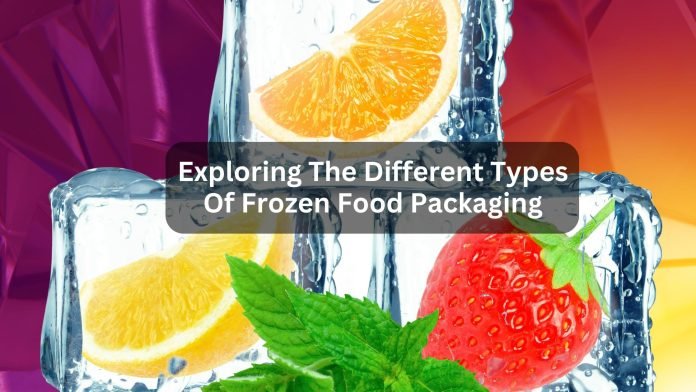When it comes to frozen food packaging, it’s crucial to prioritize safety and the preservation of product quality. Selecting the right materials and equipment that can withstand freezing temperatures is paramount in this industry. In this article, we’ll delve into the various types of packaging materials and equipment that best suit frozen food applications while also subtly highlighting the benefits of partnering with a reliable cold chain packaging company like us.
What Are The Different Types Of Frozen Food Packaging?
Frozen food packaging encompasses a wide range of materials and equipment designed to meet specific needs. Let’s explore some of the most common options available:
Shrink Film for Frozen Food Packaging
Shrink film, also known as shrink wrap, is a popular choice for packaging frozen foods. It’s a versatile plastic film, typically made of FDA-approved polyolefin, that provides an excellent seal for various frozen food items like pies, pizzas, cakes, and vegetables. Shrink film not only safeguards the product but also prevents moisture and freezer burn, ensuring your frozen delicacies reach customers in perfect condition.
Chipboard (Cardboard) for Frozen Food Packaging
Chipboard boxes are a staple in the world of frozen food packaging. Sturdy, durable, and easy to shrink wrap, these boxes are ideal for packaging pies, veggies, pizzas, cakes, and more. The ability to print vibrant branding imagery on chipboard boxes makes them visually appealing to consumers, drawing attention to your products and enticing potential buyers.
Wax Coated Cardboard for Frozen Food Packaging
Wax-coated cardboard containers are designed for frozen foods that need to be heated in their packaging. These containers are heat-resistant, making them perfect for items like Chinese food or TV dinners. While they offer convenience, it’s important to note that wax-coated cardboard is not recyclable and often ends up in landfills.
Glass for Frozen Food Packaging
Although less common in the United States, glass containers made from food-grade glass formulations find use in some food applications, especially in Asian countries. Glass containers are more frequently employed in the USA for storing leftover portions or specialty products like ice cream and gelato.
Aluminum for Frozen Food Packaging
Aluminum foil pans are a standard choice for packaging lasagna, Salisbury steaks, and other food items. These pans are often sealed with cardboard toppers and then shrink-wrapped. While aluminum is recyclable, the difficulty in cleaning used foil pans can lead to them ending up in landfills.
Flexible Bags for Frozen Food Packaging
Flexible bags, typically made of food-grade plastics or foils, are ideal for packaging frozen vegetables, fruit, pre-made meals, and more. These bags come in various forms, including stand-up pouches and pillow pouches, offering flexibility to meet different product needs.
Lidding Films for Frozen Food Packaging
Lidding films provide lids for various containers, featuring FDA approval and high-quality printing options. These films can be clear for full product visibility or customized with branding to catch the consumer’s eye in the frozen food aisle.
High Barrier Thermoforming Film for Frozen Food Packaging
High barrier thermoforming film is a specialized type of flexible packaging film known for its superior strength, puncture resistance, and glossy finish. It offers excellent protection for frozen products, ensuring their quality remains intact.
IQF Polyethylene for Frozen Food Packaging
Individually Quick Frozen (IQF) food polyethylene is a vital component of the freezing process for items such as vegetables, fruits, and more, as it preserves the integrity of the product by rapidly freezing the food without damaging its cell structure.
Skin Film for Frozen Food Packaging
Skin film is tailored to uniformly wrap products and seal them onto printed skin boards or corrugated cardboard plates. It’s commonly used for packaging seafood, providing a secure and appealing presentation.
What Are the Packaging Requirements for Frozen Products?

When packaging frozen foods, several crucial factors must be considered:
- Protection from spoilage and off-coloring
- Efficient storage
- Compliance with FDA food-grade standards
- Strength and durability
- Resistance to low temperatures, grease, oil, and water
These requirements ensure that your frozen products remain safe, visually appealing, and maintain their quality from production to the consumer’s table.
What Is the Best Packaging Material for Frozen Food?
Selecting the best packaging material for your frozen food depends on the specific product and its requirements. For sealing boxed frozen foods, polyolefin shrink film is a top choice due to its FDA approval, kosher certification, and excellent sealing capabilities. Chipboard boxes, wax-coated cardboard, and aluminum foil pans are also popular choices for various frozen food items.
What Is the Cheapest Way to Ship Frozen Food?
When it comes to shipping frozen food, cost-effectiveness and maintaining product quality are key concerns. Partnering with a reliable cold chain packaging company can help you find the most cost-efficient and safe shipping solutions tailored to your specific needs. We can assist in selecting the right packaging materials, equipment, and logistics to ensure your frozen products reach their destination in optimal condition.
Conclusion
Packaging frozen food for shipping is a complex and essential aspect of the food industry. Choosing the right materials and equipment can make a significant difference in the quality, safety, and appeal of your products. There are many cold chain packaging services that offer guidance and solutions for packaging frozen food for shipping, ensuring your frozen delicacies are packaged and shipped with care. Contact the packaging professionals to explore how they can help your business thrive in the world of frozen food packaging. Your success is our priority, and we’re here to support your journey every step of the way.


